

Exploring our past to sort out myth from reality
Share this Page on
Facebook or Twitter

These are the voyages of the TimeShip Anachron.
Our Mission: To boldly explore the past, dispelling
mythinformation and mythconceptions
of American History along the way.
 Visit us on Facebook
Visit us on Facebook
Meet MythAmerica Series

The Rise of Big Brother, Part 5
Li’l Brother is Watching You
If you were a “Child of the 1930s”—or 40s, 50s or 60s—you may well have aspired to being a “Crime Stopper” Assistant to the great comic strip detective, Dick Tracy.
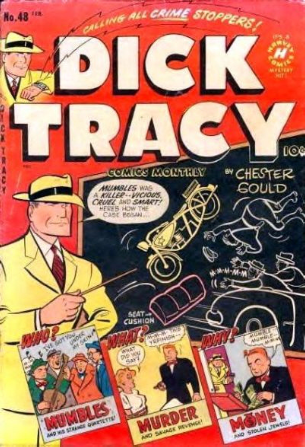
And you were in luck…with just the right combination of cereal box tops and/or stamps or change, you could “send away” (“sending away” for “premiums” was a prime pastime of children of that era) and acquire your very own Dick Tracy Crime Stopper’s badge, to prove your status to the world.

By 1961 you could send away to the Chicago Tribune and get a whole gen-
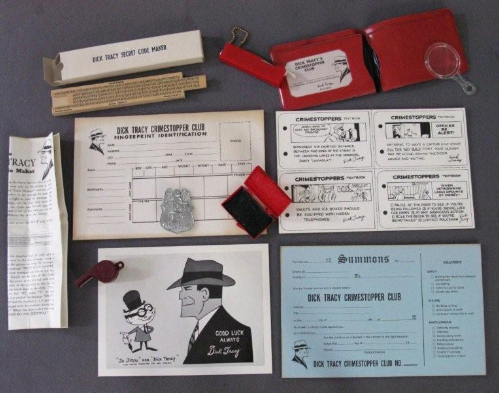
Although ads for such badges and kits, at least by the 1950s, occasionally showed aspiring young female Crimestoppers too, I think these tended to be viewed by most folks as male-
For the young lady of the family, there was a different Dick Tracy-
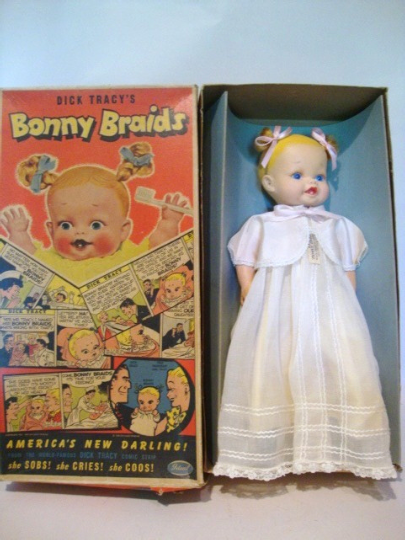
But I must admit that didn’t deter me from also dreaming about owning my very own Dick Tracy Wrist Radio. As early as 1945, you actually could get your own “It Really Works” wrist radio.
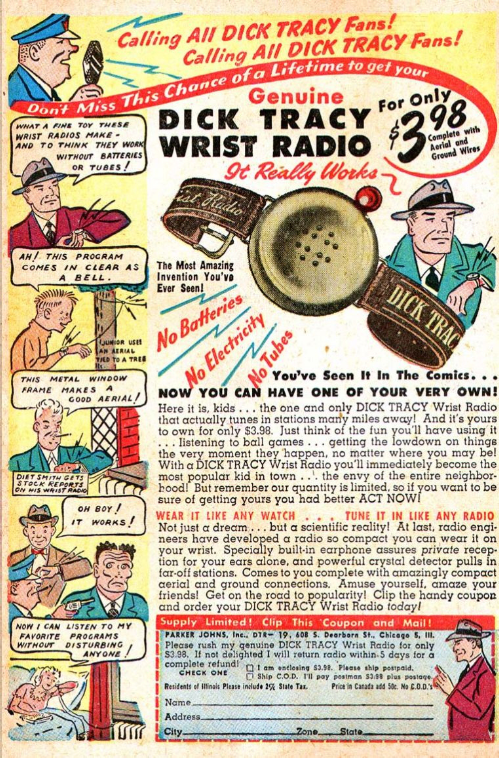
Of course, this was just a teensy little crystal radio, that only picked up commercial radio stations. And look closely at the illustration… you obviously needed to have a wire antenna connected to a nearby radiator or some such to magnify its pickup. It was painfully clear once you got past the hype in the headlines that this was not an actual “two way radio” you could use to contact Police HQ.
But by the 1960s you could get The Real Thing. Check it out on Youtube.
Well, not exactly… the wrist mike was only a part of the gadget…you had to have a big walkie-
But you know what? Even if I had my very own Crimestoppers Badge and Kit and a working model Wrist Radio as a kid, I would never have been under the illusion that I was a REAL crime stopper. I would have known I was just a kid playing pretend. And I’m pretty sure virtually all the other 6 or 8 or 10 year old kids with their badges and summons pads would have understood the same thing. We would have “arrested” each other in pretend games of Cops ‘n’ Robbers, and then parted ways to go home and watch Hopalong Cassidy on TV.
And I’m also convinced that our parents and teachers would have been equally sure that our Crimestopping antics and our summons pads were just child’s play. For after all, the emotional, social, and mental maturity level of most ten-
I say all that to say this—for some reason, this common sense conclusion about the level of responsibility of ten year olds seems to have utterly escaped the adults of a century ago. To learn more about this odd phenomenon, come along with me back to the Good Old Days of the “Anti-
The best place to start a look at the America of the early 19-
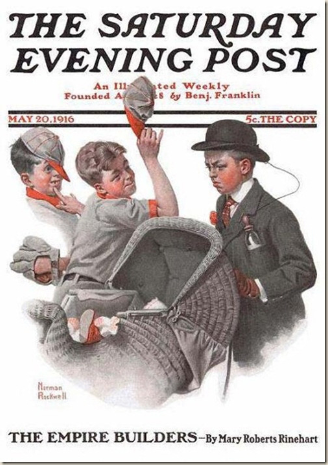
And here is one of his War Years covers, from May 15, 1918, with another lad about the same age.
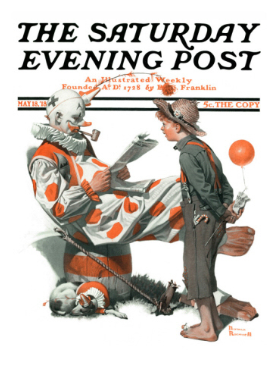
During this period, Rockwell also painted covers for other magazines, and here is one for the Literary Digest from August 7 that same year. This one also features a boy I would guess is about ten, a young red-

Collecting such buttons and badges was as popular at the time as collecting buttons and badges from radio and TV shows was in later decades. Looks like this lad was particularly dedicated in contributing to the Red Cross and Liberty Bond drives.
But after reading about some other “patriotic” efforts of lads his age, I am left wondering if that’s all he did to “do his part.” I’d be curious to know if he was a member of an Anti-
Two weeks before the Boy-
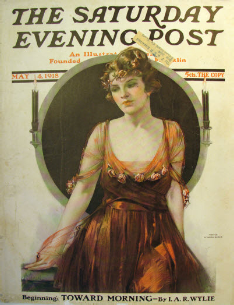
There were no young boys on this cover this time, but inside the magazine, they were running amok in a short story by an author named Henry Irving Dodge. The story, called “The Yellow Dog,” was obviously aimed at young male readers, although adults were certainly encouraged to read it too—and hopefully pass it on to the young males among their family and friends. And passed along it was! In fact, it became so popular that later that year it was separately published as a small book. And by October, it had been made into a motion picture!
In the story, a super-
When the adults in town fail to join forces to stop this threat, Walker enlists a group of young boys to become the “Boy Detectives of America.” Their mission is to “confront” any Yellow Dog that they hear saying anything negative about the War, the US, or the US Government, and to boldly ask the person “HOW DO YOU KNOW?” If he didn’t have an immediate, satisfactory answer, he was to be handed a Yellow Dog card.
Walker first came up with the idea when he noticed young boys in his neighborhood “tricking” neighbors at night by ringing their doorbells and then running. Reminiscing about similar stunts he pulled in his own childhood, he notes, “For devilish ingenuity of the teasing kind give me the small boy. Everywhere and always full of mischief. Everywhere and all at once.” And that made him sit up with a jerk and exclaim, “By Jove! I’ve got it! The small boy—the red corpuscle of the country’s blood—the universal policeman—everywhere and all at once!”
Hmm. What a mature idea. Send totally immature, thoughtless, reckless pranksters out to accost adults regarding their convictions about the most controversial political, moral, ethical, and emotionally-
A plan accepted by millions in America, as we shall soon see.
In Dodge’s story, Walker equips the corpuscles with cards full of slogans and ways to identify Yellow Dogs. They embellish and add to these. Sample:
Anybody that says US Bonds ain’t the safest investment in the world, ask him HOW HE KNOWS. If he can’t answer you he’s a yellow dog.
Any man that won’t buy a bond isn’t willing to pay his share of the expenses of our [older] brothers in the trenches who are risking their lives fighting for him.
The income tax dodger is a Yellow Dog.
Anybody that says Colonel Vanderbilt loaned France forty millions is a yellow dog. He ain’t got that much.
We’re the Boy Detectives of our town. There may be Yellow Dogs in Danforth, but there ain’t any yellow pups.
Soon even Walker was amazed at the results. The Red White and Blue Pups embarked immediately on their Children’s Crusade. And it was merciless…
Walker had forgotten how resourceful the small boy really is, how effective his patriotism becomes, once given a chance to express itself along the lines of adventure. He had thought to kindle a bonfire in Danforth. But he found he’d started a conflagration. The air was full of it. Metaphorically, it smarted the eyes and stung the nostrils of everybody. It was not long before every yellow dog in Danforth had been served with a card of identification.
And this included a large proportion of the population…because even those who weren’t “pro-
A reign of terror had descended upon the place. It got so a man didn’t dare talk sedition even to his wife in the middle of the night in his own bed, lest from out the darkness come—liked the far-
The loyal little Boy Detectives didn’t give their parents away, but they didn’t hesitate to take them to task for anything that savored of sedition. Paterfamilias [the head of the household] found that his redoubts of authority were crumbling before the constant, pin-
And now we have arrived back at Orwell’s vision of the future. Except …it’s a vision of the past. But it’s not Big Brother listening in on you in your bedroom. It’s Li’l Brother. A whole platoon of little brothers.
If I had disguised this story just a bit to not make clear the time frame, I think most readers would assume it was a cautionary bit of fiction about a dystopian future. But the readers in 1918 didn’t think it dystopian at all—they embraced the notion of a “reign of terror” by little “red corpuscles,” and thought of it as wonderfully inspiring and patriotic. So much so that they began requesting reprints of the story. At which point it became re-
As part of the promotional efforts for the book and movie, author Dodge actually officially organized the Anti-
ANTI-
Organization of Boy Detectives. Will Help Stamp Out German Propaganda in Hollywood
The latest patriotic organization to be formed in Hollywood is a branch of the “Anti-
Every boy of ten years and older is eligible to become a Boy Detective and lend his aid to running down and eliminating German propaganda Each boy who enrolls as a Boy Detective of the Anti-
Yes, just like in the Dick Tracy Crime Stoppers Kit, each Boy Detective got his own summonses to pass out. Except these weren’t just for playing cops and robbers with buddies in the alley. They were for an audacious ten or twelve year old to hand out to any adult stranger within earshot who might say something that his young mind might question. The summons wasn’t really a legal document, of course. And it only summoned the Yellow Dog to appear before the “Court of his Conscience.” But the matter MIGHT not stop in that private courtroom.
After the boys have been recruited they will be divided into squads. Each squad will be under the leadership of a Lieutenant-
Each lieutenant will have direct charge of, and be responsible for his squad of Boy Detectives, and will report at regular intervals to a District Supervisor appointed by the Anti-
In Los Angeles, as in every other city in the United States there is a certain element of alien malcontents, whose influence is anything but a patriotic stimulant. Many of them are deliberately hostile to the government, and when these are found by the Boy Detectives their names will be handed over to the regular police authorities for prompt official action.
The other species of Yellow Dog is the born American who thoughtlessly “knocks” the government. This type of Yellow Dog will be brought to his senses by the campaign of ridicule that forms the ammunition to be fired by the Boy Detective force.
The slogan of the Anti-
Among the rules of the club are the following:
“Whenever you hear a man say anything against the Government, step right up to him and ask: ‘How do you know?’
“If he don’t know, he is attacking the Government. He is a Yellow Dog spreading discouragement and discontent.
“Hand him a Yellow Dog Summons.
“If he apologizes, take back the Yellow Dog Summons. If he don’t apologize, walk away and let him keep it.”
And Hollywood was by no means an isolated venue for the Boy Detectives. I found similar articles in a Pittsburgh, Pennsylvania, paper even earlier, on August 11; a Prescott, Arizona, newspaper for September 1918; and another in a Ludington, Michigan, paper for that same month. In Prescott and Ludington, the efforts were being organized by YMCA personnel. (In many other cities they were evidently directly organized by local schools.) The Ludington paper also noted that the clubs are approved by Theodore Roosevelt.
Historical references indicate that there were around 1,000 branches of the club across the country. This would indicate tens of thousands of such boys, perhaps a hundred thousand or more. And that was just official groups of the original Dodge efforts. The idea seems to have caught on with adults as well, with copycat groups forming. Printer’s Ink magazine, a journal for advertising men, reported in its July-
I don’t doubt that all these efforts did a lot to silence open expression of dissent among the populace. But from what I can tell, virtually all the efforts of ANY of these vigilante groups, child or adult, to ferret out any actual “German spies” failed totally. And there was very little success at even finding and targeting actual enthusiastic “German sympathizers.” The primary fallout was the treatment of Americans of German descent—there were 3 million or so of them at the time. Many of these would have been in America for generations, and I would think the majority were likely American citizens. That didn’t make any difference.
The Patriotic American of 1918 was not just incensed at the militaristic current German government. He was carefully primed by peer pressure to hate “the German race.” And EVERYTHING German. Libraries burned classic literature by German authors, orchestras refused to play music by classical German composers. A movement swept across the country to expel all German language classes from American high schools—one school that didn’t cease and desist immediately was even burned down. Frankfurters were re-
And just a German last name would get you on the “profiling” list of the Boy Detectives, and other vigilante groups.
The Smallest Soldiers: Teaching Children to Hate
The ‘National School Service’ was sent to public schools throughout the country to assist teachers in making “every school pupil a messenger for Uncle Sam.” Thousands of books from mysteries to comics and adventure stories were published with hate-
Here’s a picture of my American German paternal grandfather, Lloyd Newbauer. He would have been in his 40s at the time of WW1. I wonder how he fared as the owner of a small business in Dayton, Ohio?
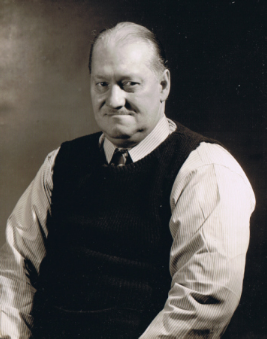
As noted with the American Protective League in previous installments of this series, the US government at the time was definitely engaged in attempting to persuade the American public to support the war efforts enthusiastically. But the government really was not the primary “enforcer” of a gung-
By mid-
So we’ve come around once again to my recurring question in this Series…was a century ago “the Good Old Days” of America? Should I yearn to go back there, to a time when every man’s home was his castle, no one interfered with his “freedom,” and the administration in Washington hadn’t become unbearably intrusive like it is now?
No thank you. I have no desire to live in an era that gave birth to whole mindless, cloned armies of both Big Brothers and Li’l Brothers fully prepared to attempt to police my every thought and opinion.
But wait. Was this all just a male phenomenon? Nah… keep reading as we explore the rise of…Big Sister.